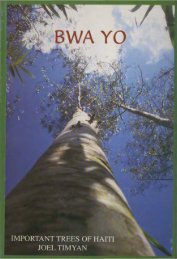Biodiversité - Société Audubon Haiti
Biodiversité - Société Audubon Haiti
Biodiversité - Société Audubon Haiti
Create successful ePaper yourself
Turn your PDF publications into a flip-book with our unique Google optimized e-Paper software.
80<br />
d) Indice de diversité alfa de Fisher (= α):<br />
S = α ln (1 + N/α)<br />
où α est la diversité alpha de Fisher, N le nombre d’individus<br />
et S le nombre d’espèces (Condit et al. 1998).<br />
Bien que connu depuis 1943, l’indice de diversité alpha de<br />
Fisher a été peu utilisé. Il a fait l’objet d’un regain d’intérêt<br />
depuis 10 à 20 ans, notamment grâce aux importants<br />
travaux du Center for Tropical Forest Science (CTFS)<br />
(Senterre 2005b).<br />
courbes aIres-esPeces<br />
et IndIvIdus-esPèces<br />
Pour estimer l’évolution de la richesse spécifique de<br />
nos différents relevés, on a réalisé des courbes aire/espèces<br />
et individus/espèces. Pour y parvenir on a fait appel à trois<br />
logiciels: Excel et Access (pour sélectionner les données et<br />
les mettre en forme) et EstimateS 7.5 (Colwell 2004).<br />
résultats<br />
dIversIté végétale<br />
consIdératIons générales<br />
Au total, 125 espèces et morpho-espèces ont été répertoriées<br />
dans les deux relevés. Celles-ci se répartissent entre<br />
53 familles et 80 genres. Dans le Tableau 3, les principaux<br />
indices de diversité et la surface ont été synthétisés pour<br />
les différents compartiments structuraux distingués sur les<br />
deux relevés réalisés.<br />
Pour les strates ligneuses, on constate que la diversité<br />
maximale s’observe dans la strate arbustive du relevé 1<br />
(limite supérieure de l’étage submontagnard, à Bois Cavalier,<br />
Formon). La strate arborée présente une diversité alpha<br />
de Fisher près de deux fois moindre. Par ailleurs, si on<br />
compare les relevés 1 et 2, il apparaît que le relevé 2 (étage<br />
montagnard, de Plaine Bœuf) est encore bien moins diversifié<br />
(Fisher alpha = 5.3). Enfin, notons que les plus faibles<br />
valeurs observées avec l’indice de Shannon pour le relevé<br />
2 et l’ensemble structural arbustif (vrais arbustes) du relevé<br />
1 traduisent le caractère nettement mono-dominant de<br />
ces ensembles. La strate arborée du relevé 1 montre également<br />
une tendance à la mono-dominance. Les différences<br />
observées au niveau spécifique s’observent également au<br />
niveau des genres et familles.<br />
La strate arborée des relevés 1 et 2 se caractérisent par un<br />
rapport «familles/espèces» ou «genres/espèces» particulièrement<br />
élevé (0.8).<br />
Pour la strate herbacée, on ne dispose pas d’un inventaire<br />
quantitatif et on ne peut donc pas comparer les indices de<br />
diversité mais on peut toutefois faire remarquer que cette<br />
strate contient les deux tiers (67 %) des espèces observées<br />
sur l’entièreté du relevé 1, pour à peine 5 % de la surface.<br />
more difference in species diversity with the dominant<br />
tree structural set. This means that the high diversity of the<br />
shrub layer is partly due to the contribution of regenerating<br />
trees species, called structural set of the future. This set of<br />
the future represent 42 % of the species and 41 % of the<br />
individuals observed within the shrub layer.<br />
contrIbutIon of bIologIcal<br />
tyPes to total dIversIty<br />
In the previous chapter, we investigated the variation of<br />
diversity between structural compartments using an index<br />
that consider the sampling effort. The submontane plot has<br />
been designed in order to get comparable sampling effort<br />
for the different strata considered. The solution is based<br />
on nested subplots of smaller size for smaller organisms,<br />
from 55 m² for herb layer to 925 m² for dominant trees. In<br />
the smaller subplot of 55 m², not only herbaceous species<br />
have been observed but all vascular plants present within<br />
the delimited surface. Therefore, it is possible to calculate<br />
the contribution of the different biological types using two<br />
sets of data: the 55 m² all-taxa inventory or the grouping<br />
of all subplots. The results are presented at Figure 5 and<br />
show that «complete plots» on a unique small surface are<br />
not the adequate methodology for estimating the relative<br />
contribution of the different biological types because<br />
it underestimates the contribution of the bigger plants<br />
such as trees and shrubs. In the submontane forest, the<br />
herbaceous structural set contributes to 44 % of all the 114<br />
species of the plot while it has been sampled on a 6 % of the<br />
total area of the plot. The high diversity of this herbaceous<br />
layer is mainly due to understory epiphytes and terrestrial<br />
herbs.<br />
dIscussIon<br />
Woody Plants dIversIty<br />
How diverse are the Macaya forests in comparison with<br />
other tropical rainforests around the world and within<br />
the Caribbean? Recently, studies on large-scale patterns<br />
of tree diversity have proliferated, mainly in the Amazon<br />
(ter Steege et al. 2003) but also in the old world (He et<br />
al. 1996; Leigh and Loo de Lao 2000; Small et al. 2004;<br />
Parmentier et al. 2006). Various groups of scientists have<br />
tried to develop standardized plot methodology in order to<br />
facilitate comparisons between regions and habitats. One<br />
of the most popular is based on 1-ha plots, situated within<br />
homogeneous stands, where all «trees» with DBH ≥ 10 cm<br />
are inventoried. The most important 1-ha plot network is<br />
the Amazonian one and is mostly concentrated on lowland<br />
terra firme forests under contrasting rainfall regimes. These<br />
plots include some of the most diversified forests of the<br />
world, at a local scale, with values of Fisher alpha up to<br />
211 in Amazonian Ecuador (at 260 m a.s.l., Valencia et al.<br />
1994). Most of the plots in western and central Amazonia<br />
have values between 50 and 200. In eastern and southern<br />
Amazonia, where the dry season length is longer, the



